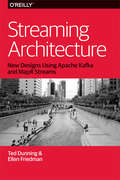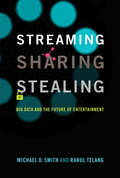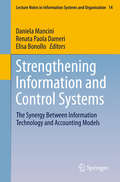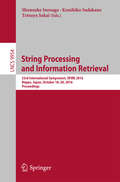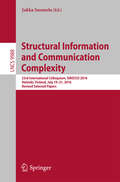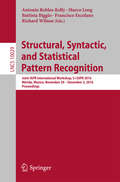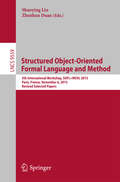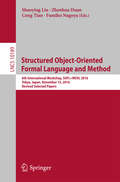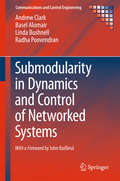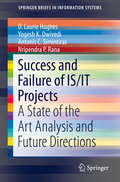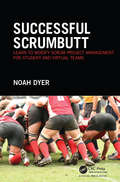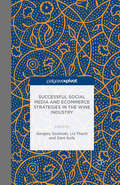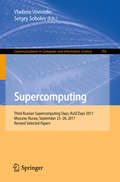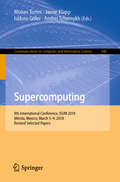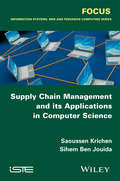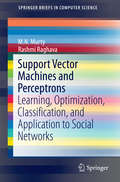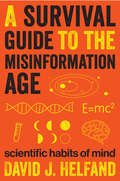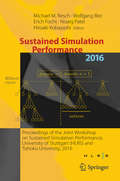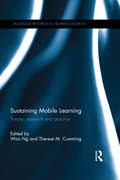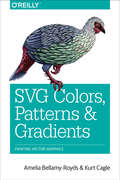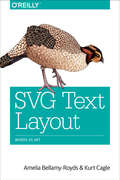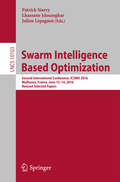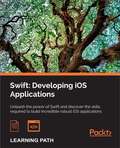- Table View
- List View
Streaming Architecture: New Designs Using Apache Kafka and MapR Streams
by Ellen Friedman Ted DunningMore and more data-driven companies are looking to adopt stream processing and streaming analytics. With this concise ebook, you'll learn best practices for designing a reliable architecture that supports this emerging big-data paradigm.Authors Ted Dunning and Ellen Friedman (Real World Hadoop) help you explore some of the best technologies to handle stream processing and analytics, with a focus on the upstream queuing or message-passing layer. To illustrate the effectiveness of these technologies, this book also includes specific use cases.Ideal for developers and non-technical people alike, this book describes:Key elements in good design for streaming analytics, focusing on the essential characteristics of the messaging layerNew messaging technologies, including Apache Kafka and MapR Streams, with links to sample codeTechnology choices for streaming analytics: Apache Spark Streaming, Apache Flink, Apache Storm, and Apache ApexHow stream-based architectures are helpful to support microservicesSpecific use cases such as fraud detection and geo-distributed data streamsTed Dunning is Chief Applications Architect at MapR Technologies, and active in the open source community. He currently serves as VP for Incubator at the Apache Foundation, as a champion and mentor for a large number of projects, and as committer and PMC member of the Apache ZooKeeper and Drill projects. Ted is on Twitter as @ted_dunning.Ellen Friedman, a committer for the Apache Drill and Apache Mahout projects, is a solutions consultant and well-known speaker and author, currently writing mainly about big data topics. With a PhD in Biochemistry, she has years of experience as a research scientist and has written about a variety of technical topics. Ellen is on Twitter as @Ellen_Friedman.
Streaming, Sharing, Stealing: Big Data and the Future of Entertainment
by Michael D. Smith Rahul TelangHow big data is transforming the creative industries, and how those industries can use lessons from Netflix, Amazon, and Apple to fight back. Traditional network television programming has always followed the same script: executives approve a pilot, order a trial number of episodes, and broadcast them, expecting viewers to watch a given show on their television sets at the same time every week. But then came Netflix's House of Cards. Netflix gauged the show's potential from data it had gathered about subscribers' preferences, ordered two seasons without seeing a pilot, and uploaded the first thirteen episodes all at once for viewers to watch whenever they wanted on the devices of their choice. In this book, Michael Smith and Rahul Telang, experts on entertainment analytics, show how the success of House of Cards upended the film and TV industries—and how companies like Amazon and Apple are changing the rules in other entertainment industries, notably publishing and music. We're living through a period of unprecedented technological disruption in the entertainment industries. Just about everything is affected: pricing, production, distribution, piracy. Smith and Telang discuss niche products and the long tail, product differentiation, price discrimination, and incentives for users not to steal content. To survive and succeed, businesses have to adapt rapidly and creatively. Smith and Telang explain how.How can companies discover who their customers are, what they want, and how much they are willing to pay for it? Data. The entertainment industries, must learn to play a little “moneyball.” The bottom line: follow the data.
Strengthening Information and Control Systems
by Elisa Bonollo Renata Paola Dameri Daniela ManciniThis book presents a collection of original research papers focused on the relationship between information technology and accounting and control models. The book discusses the importance of establishing a synergetic relationship between new information technologies (ERP, BI, web-based technology, data mining, XBRL, etc. ) and new or renewed accounting models and tools (performance indicators, prevision and simulation models, accounting models for public administration, etc. ) in order to enhance an organization's capability to manage information and make valuable decisions. The search for these synergies takes place at all organizational levels: at a strategic level, in order to simulate and forecast behaviors and financial results at a management level, in order to innovate performance measurement and improve value creation at the operational level, in order to improve information quality and the efficiency of the information process. This book is particularly useful for IS and CFO managers and scholars, as it is based on a selection of the best papers - original, double blind reviewed contributions - presented to the Annual Conference of the Italian Chapter of AIS under the category "Accounting Information Systems".
String Processing and Information Retrieval
by Shunsuke Inenaga Kunihiko Sadakane Tetsuya SakaiThis book constitutes the refereed proceedings of the 23rd International Symposium on String Processing and Information Retrieval, SPIRE 2016, held in Beppu, Japan, in October 2016. The 25 full papers presented were carefully reviewed and selected from 46 submissions. The focus of the papers is on fundamental studies of string processes and information retrieval and its applications for example to areas such as bioinformatics, Web mining and others.
Structural Information and Communication Complexity
by Jukka SuomelaThis book constitutes the refereed proceedings of the 23rd International Colloquium on Structural Information and Communication Complexity, SIROCCO 2016, held in Helsinki, Finland in July 2016. The 25 full papers presented were carefully reviewed and selected from 50 submissions. The papers are organized around the following topics: message passing; shared memory; mobile agent; data dissemination and routing.
Structural, Syntactic, and Statistical Pattern Recognition: Joint IAPR International Workshop, S+SSPR 2016, Mérida, Mexico, November 29 - December 2, 2016, Proceedings (Lecture Notes in Computer Science #10029)
by Antonio Robles-Kelly, Marco Loog, Battista Biggio, Francisco Escolano and Richard WilsonThis book constitutes the proceedings of the Joint IAPR International Workshop on Structural Syntactic, and Statistical Pattern Recognition, S+SSPR 2016, consisting of the International Workshop on Structural and Syntactic Pattern Recognition SSPR, and the International Workshop on Statistical Techniques in Pattern Recognition, SPR. The 51 full papers presented were carefully reviewed and selected from 68 submissions. They are organized in the following topical sections: dimensionality reduction, manifold learning and embedding methods; dissimilarity representations; graph-theoretic methods; model selection, classification and clustering; semi and fully supervised learning methods; shape analysis; spatio-temporal pattern recognition; structural matching; text and document analysis.
Structured Object-Oriented Formal Language and Method
by Shaoying Liu Zhenhua DuanThis book constitutes the thoroughly refereed post-workshop proceedings of the 5th International Workshop on Structured Object-Oriented Formal Language and Method, SOFL+MSVL 2015, held in Paris, France, in November 2015. The 15 papers presented in this volume were carefully reviewed and selected from 22 submissions. The focus of this workshops was on following subjects: Modeling, specification, verification, model checking, testing, debugging, transformation, and algorithm.
Structured Object-Oriented Formal Language and Method
by Shaoying Liu Zhenhua Duan Cong Tian Fumiko NagoyaThis book constitutes the thoroughly refereed post-workshop proceedings of the 5th International Workshop on Structured Object-Oriented Formal Language and Method, SOFL+MSVL 2015, held in Paris, France, in November 2015. The 15 papers presented in this volume were carefully reviewed and selected from 22 submissions. The focus of this workshops was on following subjects: Modeling, specification, verification, model checking, testing, debugging, transformation, and algorithm.
Studio Teaching in Higher Education: Selected Design Cases
by Elizabeth Boling Richard A. Schwier Colin M. Gray Kennon M. Smith Katy CampbellWell-established in some fields and still emerging in others, the studio approach to design education is an increasingly attractive mode of teaching and learning, though its variety of definitions and its high demands can make this pedagogical form somewhat daunting. Studio Teaching in Higher Education provides narrative examples of studio education written by instructors who have engaged in it, both within and outside the instructional design field. These multidisciplinary design cases are enriched by the book’s coverage of the studio concept in design education, heterogeneity of studio, commonalities in practice, and existing and emergent concerns about studio pedagogy. Prefaced by notes on how the design cases were curated and key perspectives from which the reader might view them, Studio Teaching in Higher Education is a supportive, exploratory resource for those considering or actively adapting a studio mode of teaching and learning to their own disciplines.
Submodularity in Dynamics and Control of Networked Systems
by Andrew Clark Basel Alomair Linda Bushnell Radha PoovendranThis book presents a framework for the control of networked systems utilizing submodular optimization techniques. The main focus is on selecting input nodes for the control of networked systems, an inherently discrete optimization problem with applications in power system stability, social influence dynamics, and the control of vehicle formations. The first part of the book is devoted to background information on submodular functions, matroids, and submodular optimization, and presents algorithms for distributed submodular optimization that are scalable to large networked systems. In turn, the second part develops a unifying submodular optimization approach to controlling networked systems based on multiple performance and controllability criteria. Techniques are introduced for selecting input nodes to ensure smooth convergence, synchronization, and robustness to environmental and adversarial noise. Submodular optimization is the first unifying approach towards guaranteeing both performance and controllability with provable optimality bounds in static as well as time-varying networks. Throughout the text, the submodular framework is illustrated with the help of numerical examples and application-based case studies in biological, energy and vehicular systems. The book effectively combines two areas of growing interest, and will be especially useful for researchers in control theory, applied mathematics, networking or machine learning with experience in submodular optimization but who are less familiar with the problems and tools available for networked systems (or vice versa). It will also benefit graduate students, offering consistent terminology and notation that greatly reduces the initial effort associated with beginning a course of study in a new area.
Success and Failure of IS/IT Projects
by D. Laurie Hughes Yogesh K. Dwivedi Antonis C. Simintiras Nripendra P. RanaThis book examines the link between change and project management and how creating a closer alignment between these two methodologies can yield greater benefits and mitigate elements of failure of information systems (IS) projects. This study explores the underlying challenges and practicalities of closer integration of the two disciplines and asserts that such a successful change goes beyond the simple training of project managers in the practitioner context. Instead, it requires organizations to conceptualize the necessary challenges to realize the potential benefits of this recommended integrated approach. The integration of both project and change management has been advocated in existing research, but the challenges of moving from a current position of separate methodologies, different standards bodies and in some cases totally separate organizational structures, is a step change for many organizations. Change initiatives where good change management practices are implemented, can increase the probability of successful organizational change. The tasks of leading and sustaining change can be complex and often entail the interplay of multiple factors involving action by people at every level of the business. This book offers a guide that identifies the barriers and major challenges that may arise in the development of the closer integration of change and project management. With a better understanding of these issues, organizations can avoid such pitfalls when establishing their own integrated approach.
Successful ScrumButt: Learn to Modify Scrum Project Management for Student and Virtual Teams
by Noah DyerHave you ever seen a promising project get abandoned right when it seemed like it was getting ready to launch, or a project that always seemed like it was going to launch "next month," but took many months or even years before it actually launched? Scrum may be the solution to such woes. It is a project management methodology that, when applied faithfully, will increase the rate at which your project is completed, the enjoyment your team has while working on it, and its commercial success. Converting to scrum can be a challenge for any team, but it is particularly painful for part time, virtual, and student teams. Successful Scrumbutt helps teams quickly learn scrum project management and adapt it to their unique situations. Author Noah Dyer illustrates key techniques for maintaining a team's productivity and enthusiasm for a project across its lifetime in fun, engaging, and slightly irreverent ways. Key Features Learn key techniques for maintaining enthusiasm for your project across its lifetime and have the confidence that every hour spent on your project is having maximum benefit. Includes instructions for using Assembla and other popular and free Scrum software. This will save people time identifying and learning a software package to help implement Scrum principles. Activities to introduce people to Scrum and practice Scrum principles. These are fun ways to learn Scrum in a low pressure atmosphere where delivery and execution are not paramount. Soft Skills Sections help readers understand not only the action to be taken and the principle, but how to effectively communicate with others regarding Scrum practices, particularly problem solving. Excel templates, activities for implementing Scrum in a low tech environment and planning cards that make Scrum planning activities easier and feel more official are included for download and easy printing. Do It Now: Tips for integrating the principle in a chapter right away, even if full Scrum is not yet fully understood and achievable.
Successful Social Media and Ecommerce Strategies in the Wine Industry
by Gergely Sznolnoki Liz Thach Dani KolbThis book focuses on principles and practices in digital wine marketing. By providing a global overview of social media and e-commerce strategies and practices in the wine business, this book allows readers to understand how consumers and producers deal with these modern communication and selling platforms.
Summoners War La Guía no Oficial del Juego
by Sergio Yagüe-Pasamón Joshua Abbott¡Con mi guía no oficial, aprenderás absolutamente todo sobre este juego! Las estrategias mencionadas en esta guía son conocidas únicamente por los jugadores de élite que han conseguido las mejores puntuaciones y te llevarán a nuevas cuotas de éxito en el juego. Esta guía cubre lo siguiente: - Estrategias para novatos. - Todo sobre los monstruos - Como vencer a tus oponentes en los duelos - Como ganar oro. - Todo sobre el mapa. - Trucos, hacks y modificaciones para hacer el juego más fácil. - ¡Secretos, consejos y trucos utilizados por jugadores profesionales! - Estrategias generales del juego. - ¡Y mucho más! ¡Cómprala ahora y no te quedes atascado intentando acabar un nivel o perdiendo todas tus vidas! ¡Conviértete en un jugador de altas puntuaciones hoy mismo! Descargo de responsabilidad: Este producto no está asociado, afiliado, respaldado, revisado, examinado, certificado o promocionado por su creador original, Com2us. Esta guía debe usarse como referencia y no pretende modificar o alterar el juego de forma alguna. Todos los contenidos de la misma deben usarse bajo tu responsabilidad.
Supercomputing
by Vladimir Voevodin Sergey SobolevThis book constitutes the refereed proceedings of the Second Russian Supercomputing Days, RuSCDays 2016, held in Moscow, Russia, in September 2016. The 28 revised full papers presented were carefully reviewed and selected from 94 submissions. The papers are organized in topical sections on the present of supercomputing: large tasks solving experience; the future of supercomputing: new technologies.
Supercomputing: 9th International Conference, Isum 2018, Mérida, Mexico, March 5-9, 2018, Revised Selected Papers (Communications in Computer and Information Science #948)
by Moises Torres Jaime Klapp Isidoro Gitler Andrei TchernykhThis book constitutes the refereed proceedings of the 9th International Conference on Supercomputing, ISUM 2018, held in Mérida, Mexico, in March 2018. <P><P> The 19 revised full papers presented were carefully reviewed and selected from 64 submissions. The papers are organized in topical sections on scheduling, architecture, and programming; parallel computing; applications and HPC.
Supply Chain Management and its Applications in Computer Science
by Saoussen Krichen Sihem Ben JouidaSupply chain management is a key topic for a large variety of strategic decision problems. It is essential in making efficient decisions related to the management of inventory and the delivery of final products to customers. The focus of this book is the understanding of the supply chain taxonomy, the different levels of decision and the impact of one level on another depending on the modeling of the addressed objectives. The authors explore the potential problems that can be addressed within the supply chain, such as the inventory, the transportation and issues of holding, and find applications in numerous fields of study, from cloud computing and networking through to industrial sciences. The reader can find each issue described and its positioning in the supply chain determined. A computer science framework is also developed to show how the use of electronic platforms can aid in the handling of these potential problems.
Support Vector Machines and Perceptrons
by M. N. Murty Rashmi RaghavaThis work reviews the state of the art in SVM and perceptron classifiers. A Support Vector Machine (SVM) is easily the most popular tool for dealing with a variety of machine-learning tasks, including classification. SVMs are associated with maximizing the margin between two classes. The concerned optimization problem is a convex optimization guaranteeing a globally optimal solution. The weight vector associated with SVM is obtained by a linear combination of some of the boundary and noisy vectors. Further, when the data are not linearly separable, tuning the coefficient of the regularization term becomes crucial. Even though SVMs have popularized the kernel trick, in most of the practical applications that are high-dimensional, linear SVMs are popularly used. The text examines applications to social and information networks. The work also discusses another popular linear classifier, the perceptron, and compares its performance with that of the SVM in different application areas. >
A Survival Guide to the Misinformation Age: Scientific Habits of Mind
by David J. HelfandLearning how to tell news from fake news from fake fake news: An &“important and timely&” book on protecting ourselves, and society, from the infodemic (Library Journal). We have billions of bytes of data at our fingertips. But how much of it is misinformation—or even disinformation? A lot of it is, and your search engine can&’t tell the difference. As a result, an avalanche of misinformation threatens to overwhelm the discourse we so desperately need to address complex social problems such as climate change, the food and water crises, biodiversity collapse, and emerging threats to public health. This book provides an inoculation against the misinformation epidemic by cultivating scientific habits of mind. Anyone can do it—indeed, everyone must do it if our species is to survive on this crowded and finite planet. This survival guide supplies an essential set of apps for the prefrontal cortex while making science both accessible and entertaining. It will dissolve your fear of numbers, demystify graphs, and elucidate the key concepts of probability, all while celebrating the precise use of language and logic. David Helfand, one of our nation&’s leading astronomers and science educators, has taught scientific habits of mind to generations in the classroom, where he continues to wage a provocative battle against sloppy thinking and the encroachment of misinformation. &“Provides a vital antidote to the ills of misinformation by teaching systematic and rigorous scientific reasoning.&” —The Times Literary Supplement
Sustained Simulation Performance 2016
by Michael M. Resch Wolfgang Bez Erich Focht Nisarg Patel Hiroaki KobayashiThe book presents the state of the art in high-performance computing and simulation on modern supercomputer architectures. It explores general trends in hardware and software development, and then focuses specifically on the future of high-performance systems and heterogeneous architectures. It also covers applications such as computational fluid dynamics, material science, medical applications and climate research and discusses innovative fields like coupled multi-physics or multi-scale simulations. The papers included were selected from the presentations given at the 20th Workshop on Sustained Simulation Performance at the HLRS, University of Stuttgart, Germany in December 2015, and the subsequent Workshop on Sustained Simulation Performance at Tohoku University in February 2016.
Sustaining Mobile Learning: Theory, research and practice (Routledge Research in Higher Education)
by Wan Ng Therese M. CummingMobile technologies are one of the fastest growing areas of technology in education. For learners, they offer an appealing opportunity to transcend teacher-defined knowledge and approaches by being able to access multiple, alternative sources of information anytime and anywhere. While the pace of engagement with and research into the educational applications of mobile technologies has picked up dramatically in the last decade, there is no consolidated view of how to sustain the practices or opportunities that are being explored. Sustainability is a complex but crucial issue in mobile learning as educational institutions are usually required to make substantial investments in mobile devices and associated technologies, time and training to initiate mobile learning programs. The complexity of sustainable mobile learning programs is further exacerbated by the fast pace of change of digital technologies, where with every change, new possibilities are opened up and investments required. In addition, educators are still attempting to reconcile institutions of formal education with informal mobile learning. The book addresses these issues, with a particular focus on: exploring the challenges surrounding the sustainability of mobile learning in K-12 and higher education investigating the importance of sustaining mobile learning for diverse populations of students globally discussing theoretical models for the sustainability of mobile learning providing the reader with strategies for sustaining mobile learning. Presenting new research alongside theoretical models and ideas for practice, the book will appeal to researchers, academics, and postgraduate students in the fields of education and mobile learning, as well as those working in teacher education.
SVG Colors, Patterns & Gradients
by Kurt Cagle Amelia Bellamy-RoydsAs a vector graphics format, SVG uses precisely-defined geometric shapes to build an image. But that doesn't mean that SVG graphics have to look like technical drawings. SVG graphics can be shaded, textured, built from partially-transparent overlapping layers, or even filled with photographic images.SVG Colors, Patterns, and Gradients takes an in-depth look at the different ways SVG text and shapes can be painted on the screen or page. You'll start with an overview of how color is defined, including the various ways you can control the transparency of SVG content. You'll then dive deep into the concept of an SVG paint server: gradients, patterns, and other complex graphical content that can be used to fill-in or outline other SVG shapes and text.
SVG Text Layout
by Kurt Cagle Amelia Bellamy-RoydsAlthough SVG is mostly known as a graphics format, one of its key benefits is that it encodes decorative text in a way that is editable, accessible, and search engine-discoverable. The SVG specifications give designers extensive control over the positioning and appearance of text--but at the cost of many of the automatic text layout settings used for paragraphs on a web page.SVG Text Layout takes an in-depth look at the many ways designers can manipulate text within SVG, from adding simple text labels to letter-by-letter positioning of artistic text. You'll learn how both artistic fonts and SVG painting effects can be used to decorate text, and discusses various approaches for increasing consistency between different web browsers and other software.
Swarm Intelligence Based Optimization
by Patrick Siarry Lhassane Idoumghar Julien LepagnotThis book constitutes the thoroughly refereed post-conference proceedings of the 1st International Conference on Swarm Intelligence Based Optimization, ICSIBO 2014, held in Mulhouse, France, in May 2014. The 20 full papers presented were carefully reviewed and selected from 48 submissions. Topics of interest presented and discussed in the conference focuses on the theoretical progress of swarm intelligence metaheuristics and their applications in areas such as: theoretical advances of swarm intelligence metaheuristics, combinatorial, discrete, binary, constrained, multi-objective, multi-modal, dynamic, noisy, and large-scale optimization, artificial immune systems, particle swarms, ant colony, bacterial foraging, artificial bees, fireflies algorithm, hybridization of algorithms, parallel/distributed computing, machine learning, data mining, data clustering, decision making and multi-agent systems based on swarm intelligence principles, adaptation and applications of swarm intelligence principles to real world problems in various domains.
Swift: Developing iOS Applications
by Giordano Scalzo Jon Hoffman Andrew J WagnerUnleash the power of Swift and discover the skills required to build incredible robust iOS applications About This Book * Write expressive, understandable, and maintainable Swift 2 code with this hands-on course * Unveil the complex underpinnings of Swift to turn your app ideas into reality * Specialize in developing real iOS apps, and 2D and 3D video games using Swift and Cocoapods * Dive deep into protocol extensions, learn new error handling model and use featured Swift design patterns to write more efficient code Who This Book Is For This course would be for app developers who are new to developing for iOS or OSX and are trying to get grips with Swift for the first time. What You Will Learn * From a solid understanding of the Swift 2 language * Get to know the practical aspects of how a computer program actually works * Understand the paradigms used by Apple's frameworks, so you are not intimidated by them * Create a server in Swift to deliver JSON data to an iOS app * Take advantage of Cocoapods to use third-party libraries * Build games with SpriteKit and SceneKit * Develop an app running on the cloud to act as an API server for your client's apps * Dive into the core components of Swift 2 including operators, collections, control flow, and functions * Create and use classes, structures, and enums including object-oriented topics such as inheritance, protocols, and extensions * Develop a practical understanding of subscripts, optionals, and closures * Master Objective-C interoperability with mix and match * Access network resources using Swift * Implement various standard design patterns in the Swift language In Detail The Swift--Developing iOS Applications course will take you on a journey to become an efficient iOS and OS X developer, with the latest trending topic in town. Right from the basics to the advanced level topics, this course would cover everything in detail. We'll embark our journey by dividing the learning path into four modules. Each of these modules are a mini course in their own right; and as you complete each one, you'll gain key skills and be ready for the material in the next module. The first module is like a step-by-step guide to programming in Swift 2. Each topic is separated into compressible sections that are full of practical examples and easy-to-understand explanations. Each section builds on the previous topics, so you can develop a proficient and comprehensive understanding of app development in Swift 2. By the end of this module, you'll have a basic understanding of Swift 2 and its functionalities. The second module will be the an easy-to-follow guide filled with tutorials to show you how to build real-world apps. The difficulty and complexity level increases chapter by chapter. Each chapter is dedicated to build a new app, beginning from a basic and unstyled app through to a full 3D game. The last two chapters show you how to build a complete client-server e-commerce app right from scratch. You'll be able to build well-designed apps, effectively use AutoLayout, develop videogames, and build server apps. The third and the last module of our course will take an example-based approach where each concept covered is supported by example code to not only give you a good understanding of the concept, but also to demonstrate how to properly implement it. Style and approach This course includes all the resources that will help you jump into the app development .This course covers all the important aspects Swift application development and is divided into individual modules so that you develop your skill after the completion of a module and get ready for the next. Through this comprehensive course, you'll learn how to use Swift programming with hands-on examples from scratch to finish!
